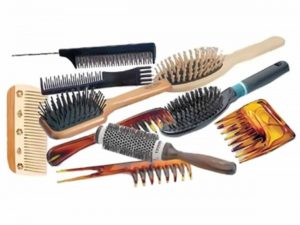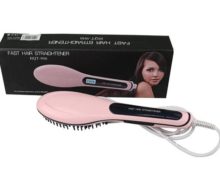Behind the simple word “comb” lies an object that, from a professional point of view, is of interest to specialists in completely different fields. Hairdressers use it to help clients look better, criminologists solve crimes, geneticists confirm kinship, and fortune tellers predict the future. For an ordinary person, a brush is, first of all, a tool that helps to take care of oneself.
Comb - what kind of hygiene item?
 This is an individual device for caring for hair, and sometimes for the scalp. The item belongs to the category of household and personal, but there are also professional tools. They are used in work by representatives of some professions. For example, stylists and hairdressers.
This is an individual device for caring for hair, and sometimes for the scalp. The item belongs to the category of household and personal, but there are also professional tools. They are used in work by representatives of some professions. For example, stylists and hairdressers.
There are also therapeutic and medical devices. Most often they are prescribed by a trichologist or dermatologist and are intended to treat diseases or eliminate cosmetic imperfections.
Historical reference
 The journey of this hair tool, according to the most conservative estimates, began 10 thousand years ago. The specimen found in the excavations was made of fish bone and served as decoration rather than a functional device for maintaining hygiene. Brushes began to play a similar role later.
The journey of this hair tool, according to the most conservative estimates, began 10 thousand years ago. The specimen found in the excavations was made of fish bone and served as decoration rather than a functional device for maintaining hygiene. Brushes began to play a similar role later.
Combs were definitely used for combing during the heyday of Ancient Greece. Additionally, combs, or more precisely, their middle parts - butts - were used in this country to store poisons and perfumes. The most surprising thing is that this is not the most unusual way to use it. Thus, among the eastern peoples and Slavs, the accessory acted as a magical attribute, and for medieval European ladies it was a dresser. They stuck it into the hairstyle, which was not left out due to the multi-story structure and complexity of its creation, and they used it to scratch their head, which was itchy from the attack and the abundance of insects.
For Japanese samurai and geisha, combs were not only a personal hygiene item, but also a weapon. Well, for men of other classes, the comb was considered a love attribute, allowing a non-verbal way to show their sympathy for a girl. The same method of application has taken root on Russian soil.
Important! The cost of an individual brush dropped significantly immediately after the invention of plastic. This happened in the 19th century. Since then, the comb has entered every home and has truly become a personal hygiene item.
Purpose of the comb
Main roles of the brush:
 separation of strands;
separation of strands;- creating hairstyles, styling, waves, backcombing, root volume;
- head massage;
- prevention of splitting;
- combing out dandruff and parasites;
- removal of small debris and fallen hairs;
- uniform distribution of natural fat on the hair along its entire length.
There are also non-standard methods of application.Thus, models for babies help remove birth crusts from the scalp and relieve natural itching caused by their peeling. In addition, there are role-playing games that involve using different sides of the massage brush. And fortune tellers and psychics use brushes and hair from them in love, healing and predictive magic.
There are also “smart” combs designed to solve specific purposes:
- straightening (they cope with the task much faster than ironing, literally in 5–10 minutes);
- creating waves and curls (thermal brushing - a round brushing comb with holes on the body through which hot air flows are supplied);
- treatment of severe hair loss, including age-related (for example, laser comb);
- removal of electrification (for example, an ionizing brush).
What shapes do combs come in?
The fundamental classification divides the variety of options into 2 categories: models with teeth and combs with bristles. The first group consists of the following types:
 a comb with teeth arranged in 1 row (comb);
a comb with teeth arranged in 1 row (comb);- a comb with teeth scattered over the head area (massage brush);
- classic comb (does not have a handle);
- comb for hair extensions (the teeth are not straight, they have the shape of loops);
- comb-clip (suitable for combing and pinning up hair; has very long teeth);
- medical comb (designed for combing; prescribed for certain hair and skin diseases, as well as for patients suffering from lice);
- comb with a handle (long or short);
- double-sided comb (the comb is located in the center, and there are teeth to the left and right of it).
The ridges, in turn, can be frequent, sparse or combined.In the latter type of comb, some of the teeth are sparse, and some are frequent.
Important! Both combs and massage combs, in turn, can be regular or folding (flip-flop). The last variation is compact and easily fits in a bag, but is often not suitable for complex hair manipulations.
Bristle brushes come in massage and round types.. The first ones are suitable for prolonged combing. They do not frizz hair, but soothe it and increase blood circulation in the cells of the scalp. Round ones are primarily designed for styling. Helps create curls and waves of different sizes.
There is also a division based on the location of the bristles.. Single associations can be evenly scattered over the entire area of the shell, in bunches or in rows. Also takes into account the origin of the bristles. The best option is considered to be accessories made using materials obtained from wild boars. They return a healthy shine to the hair, take care of the strands and promote their restoration, and prevent splitting.
Types of combs by material
Wooden
 They do not electrify hair, handle curls with care, and do not injure the skin. Can be used during coloring (will not affect the result), on damp hair and when styling with a hairdryer. Due to the variety of brushes, it is possible to choose a model for specific tasks (for combing, massage, constantly carrying in a purse or for creating hairstyles) and for a certain type of hair (for thick, severely damaged, sparse, curly).
They do not electrify hair, handle curls with care, and do not injure the skin. Can be used during coloring (will not affect the result), on damp hair and when styling with a hairdryer. Due to the variety of brushes, it is possible to choose a model for specific tasks (for combing, massage, constantly carrying in a purse or for creating hairstyles) and for a certain type of hair (for thick, severely damaged, sparse, curly).
Important! Varnished wooden brushes lack many of the advantages of uncoated brushes. For example, they create an electrical discharge when brushed for a long time and thoroughly.
In addition to advantages, they also have disadvantages. The insurmountable “disadvantages” include a short operational life. Its short duration is explained by the fact that the tree does not tolerate contact with liquids. At the same time, wooden brushes absorb skin secretions well, so for hygienic reasons they should not be washed. It turns out to be a vicious circle, the way out of which is to frequently purchase a new comb.
Important! If you want to change your hair brush as rarely as possible, take a closer look at a product made from coniferous wood. Their wood is denser, but softer, and therefore does not react so sharply to contact with water.
Metal
 They do not bend, do not break, perfectly separate strands and are ideal for creating backcombing. Wherein handle strands and scalp roughly: can cause injury and hair splitting. Fewer risks are associated with the use of metal combs with rounded tips. The danger is almost completely absent in the case of massage combs, the tops of which are equipped with plastic or silicone rounds.
They do not bend, do not break, perfectly separate strands and are ideal for creating backcombing. Wherein handle strands and scalp roughly: can cause injury and hair splitting. Fewer risks are associated with the use of metal combs with rounded tips. The danger is almost completely absent in the case of massage combs, the tops of which are equipped with plastic or silicone rounds.
Important! Metal combs are not used at the same time as a hair dryer because their material heats up quickly and therefore burns the hair.
Plastic
Inexpensive, easy to clean, lightweight, you can buy a product of any type and design. At the same time, models made of thin plastic bend, lose teeth and are unable to comb heavy, long hair. In addition, they cannot be used together with a hairdryer - when heated, the material begins to emit a pungent odor.
Important! Plastic brushes are not suitable for prolonged combing, as they create an electrical discharge due to friction.
Low-quality plastic is also dangerous due to delamination. After losing their smoothness, the teeth begin to damage the hair structure and scratch the skin. Therefore, combs made from this material should only be purchased in professional stores. The products sold there are free from the disadvantages described above: they do not bend, are coated with an antistatic layer, and are not prone to premature wear.
Bone
They handle strands with care and are durable. Humane treatment of animals and the emergence of analogue materials have led to a significant reduction in bone combs in the hair tools market. Now such products expensive, rare, used mainly during long evening combing.
Silicone
 They are easy to clean, weigh little, and last a long time. Suitable for all hair manipulations, including coloring and creating hairstyles using a hair dryer.
They are easy to clean, weigh little, and last a long time. Suitable for all hair manipulations, including coloring and creating hairstyles using a hair dryer.
Carbon
Very durable, non-electrifying, easy to clean, and separates strands well. Suitable for coloring and creating hairstyles, drying hair. Neutral for curls and scalp.
With natural bristles
Suitable for massage and prolonged combing, soothes electrified strands and improves blood circulation. Ideal for severely damaged ends, but unacceptable for quickly dirty curls. Oily hair at the roots looks even more unkempt after using a brush with natural bristles.


 separation of strands;
separation of strands; a comb with teeth arranged in 1 row (comb);
a comb with teeth arranged in 1 row (comb); 1
1





